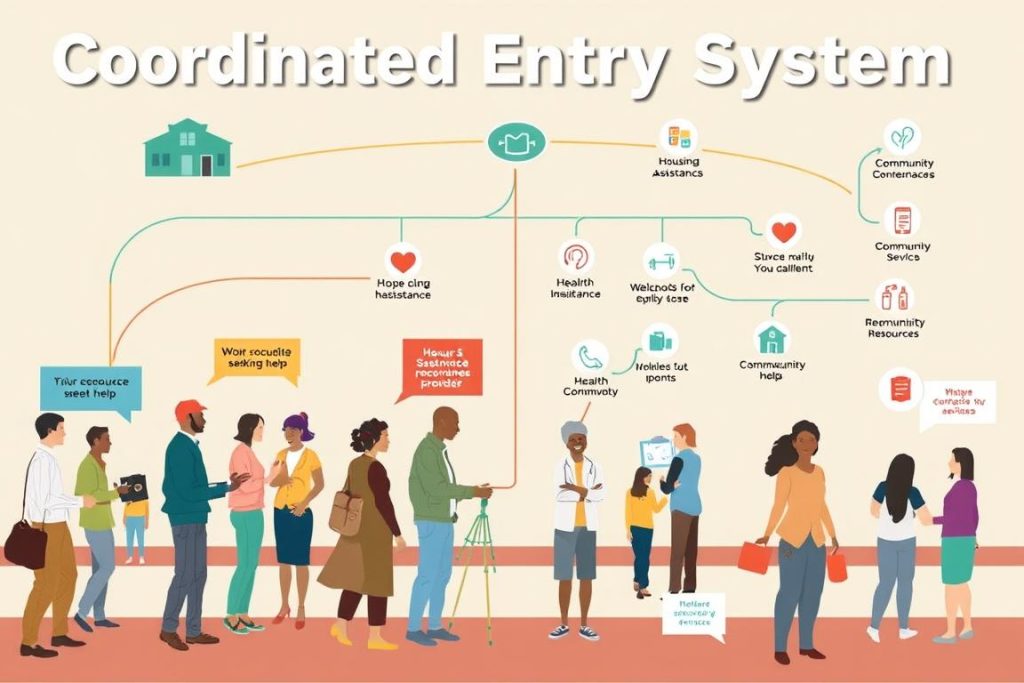Imagine walking through the busy streets of your city. Suddenly, you see someone you know—the local librarian who always had the best book recommendations. But today, they’re not in the library. They’re outside, holding a worn-out blanket, facing a harsh new reality without a home. This story, while made up, reflects the harsh truth for many older Americans suddenly battling homelessness. The necessity for effective homeless assistance programs is clear. The Continuum of Care (CoC) shines as a ray of hope, offering shelter and stability opportunities.
This issue calls for immediate action. Communities all over are working hard to offer homelessness resources and crucial shelter services. Shockingly, reports show that over one-third of adults facing chronic homelessness are over 551. Racial disparities make things even harder, especially for Black elders struggling to find stable housing2. The CoC program, spearheaded by HUD, emphasizes continuous support for the homeless, anchored in a Housing First model that simplifies access to shelter and care1.
Community outreach programs are critical, focusing on families and individuals in dire need. They offer Permanent Supportive Housing to help disabled persons overcome the challenges of homelessness13. When exploring HUD’s rationale for choosing specific assessment tools, we see the emphasis on helping the most vulnerable3. Each effort, whether a HUD-funded project or local initiative, represents a move toward ensuring stability and respect for those in great need.
Key Takeaways
- The Continuum of Care program is central to HUD’s mission to combat homelessness.
- PSH addresses the intersection of disability and homelessness with housing and services.
- Housing First models prioritize immediate access to housing for the homeless without preconditions.
- Coordination within communities is key to effective homeless assistance program implementation.
- Homelessness resources and shelter services are critical components of CoC efforts.
- Community outreach programs play a significant role in supporting HUD’s nationwide objectives.
- Understanding the coordinated entry process is crucial for connecting individuals to the necessary resources.
Understanding HUD’s Continuum of Care Program
The start of HUD’s Continuum of Care program was a major change in how we tackle homelessness in communities. It brought together services in both cities and rural areas to help the homeless. This program coordinates efforts to give people a way out of homelessness.
To really reduce homelessness, we need a plan that meets urgent needs and offers lasting solutions. The program includes emergency shelters, transitional housing, and long-term housing support. These help people move from living on the streets to stable homes.
Origins and Goals: Reducing Homelessness through Community Efforts
The McKinney-Vento Homeless Assistance Act changed with the HEARTH Act of 2009, making the Continuum of Care program better. It put different efforts under one roof to make helping the homeless more effective. These changes aimed to get ahead of homelessness and improve coordination in communities4.
Key Components: Emergency Shelter, Transitional Housing, Rapid Re-housing, and PSH
The Continuum of Care breaks down help into clear steps for people facing homelessness. There are emergency shelters for immediate help and transitional housing for temporary support. Rapid re-housing helps people quickly find a lasting home5. Permanent supportive housing (PSH) gives long-term aid, especially to those with disabilities, improving their lives significantly4.
Importance of Permanent Supportive Housing (PSH) for Disabled Individuals
Permanent supportive housing is key for those with disabilities within HUD’s Continuum of Care program. It offers not just a place to live, but specialized support services. These include behavioral health and case management, essential for long-term stability.
HUD’s Housing First Model: A Proactive Approach to Homeless Assistance
HUD’s Housing First model changes the game by offering housing first, without preconditions. This method works well, along with affordable housing and follow-up services to help people adjust. It removes obstacles like credit checks, welcoming everyone and promoting inclusivity4.
In conclusion, the Continuum of Care sets a strong foundation for ending homelessness through coordinated community efforts. It covers everything from emergency shelter to making transitional housing available. This program is key to HUD’s overall mission to provide safe, affordable housing and necessary support for all.
Homeless Assistance Programs: Coordinated Entry and Community Planning
The core of effective homeless help is a strong coordinated entry system. It makes sure you, or anyone who needs help, can find their way through an organized process. This process quickly connects people with the essential homelessness resources and support they need. A community planning approach is used, involving a consistent assessment to be the main way to get various kinds of help for the homeless.

When someone enters the system, they are checked with a special tool designed for specific groups. This method makes sure those in most need get help first, making the best use of available resources. It ensures that help is given based on how urgent someone’s situation is, not on who came first67.
The setup is designed to be open and fair for all. There are special entry points for adults, families, and youth, making sure everyone has the right help available. The assessment, taking about 15-25 minutes, speeds up getting help to those in need. Plus, updating this information every 90 days keeps the system accurate and up to date7.
Beyond just starting to get help, ongoing community work and planning are crucial. They focus not only on short-term help but also on lasting solutions. These efforts are in line with HUD’s strategic goals, involving many community groups. Among these efforts is Project Roomkey, which has successfully provided safe, temporary housing during tough times8.
Fighting homelessness is a big challenge, but we can make real progress with coordinated efforts and thoughtful planning. The dedication of many people to keep these systems working shows a strong commitment to ending homelessness. These programs are key to community-driven efforts to prevent and address homelessness.
Conclusion
The Continuum of Care (CoC) by HUD combines important elements. These include emergency shelter and permanent supportive housing. This blend is crucial for steady housing.
Adding the Housing First principle, these programs do more than offer quick help. They are long-term solutions that lessen homelessness and better lives.
Yet, challenges remain. For example, California faces big budget cuts in housing and homelessness programs. Governor Gavin Newsom’s budget reduces the homeless funding by $260 million9. It also might cut $20 billion from the San Francisco Bay Area’s housing bond. Plus, about 46,605 ready-to-build affordable homes face delays due to lacking funds9.
But it’s not all bleak. The No Place Like Home program, starting on July 1, 2016, puts nearly $2 billion towards housing for those with severe mental health issues10.
When you support these efforts, remember their success relies on community support and steady funding. Your actions can help keep programs like CoC at the forefront for housing stability. Being involved and up-to-date, especially with No Place Like Home’s funding10, is essential. Let’s work together to tackle hurdles and support stable, affordable housing for everyone.
For more insight into how permanent supportive housing fights chronic homelessness, check out this detailed report9.
FAQ
What is the Continuum of Care (CoC) Program?
How does the CoC Program help reduce homelessness?
What services are included in the CoC Program’s approach to homeless assistance?
Why is Permanent Supportive Housing (PSH) important?
What is HUD’s Housing First Model?
How does the Coordinated Entry System work?
What role does community planning play in the CoC Program?
Source Links
- HUD Homeless Assistance Programs: A Basic Primer for Aging Advocates – Justice in Aging – https://justiceinaging.org/hud-homeless-assistance-programs-a-basic-primer-for-aging-advocates/
- Responding to Homelessness | PMHC Toolkit | Bureau of Justice Assistance – https://bja.ojp.gov/program/pmhc/responding-homelessness
- Continuum of Care FAQs – https://www.hud.gov/program_offices/comm_planning/coc/faqs
- CoC Program Toolkit – Introduction to the CoC Program – https://www.hudexchange.info/programs/coc/toolkit/introduction-to-the-coc-program/
- What is a Continuum of Care? – https://endhomelessness.org/resource/what-is-a-continuum-of-care/
- Coordinated Entry – https://hsh.sfgov.org/services/the-homelessness-response-system/coordinated-entry/
- Coordinated Entry System of Homeless Services (CES) – https://www.howardcountymd.gov/homeless-services/coordinated-entry-system-homeless-services-ces
- Housing Programs – https://www.cdss.ca.gov/inforesources/cdss-programs/housing-programs
- Amid deficit, Newsom proposes California spend less to solve homelessness and create affordable housing – https://calmatters.org/housing/2024/05/may-revise-2024-homeless-housing/
- No Place Like Home Program – https://www.hcd.ca.gov/grants-and-funding/programs-active/no-place-like-home-program


